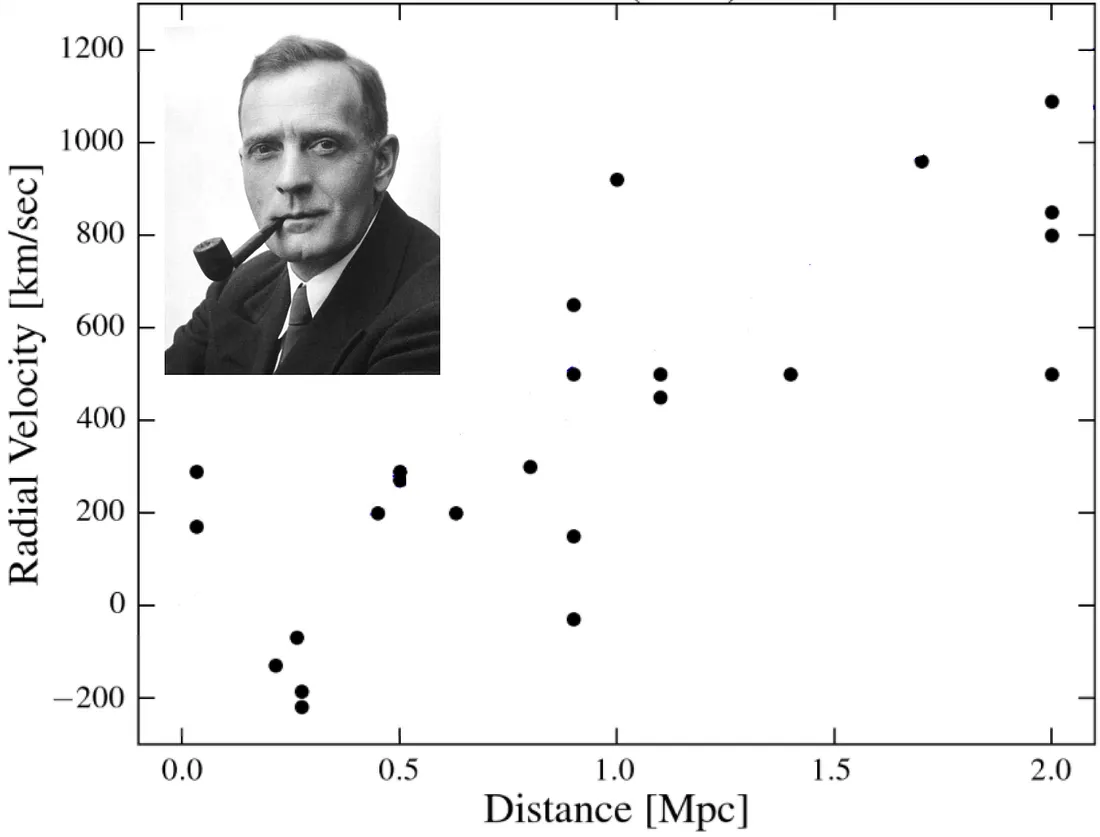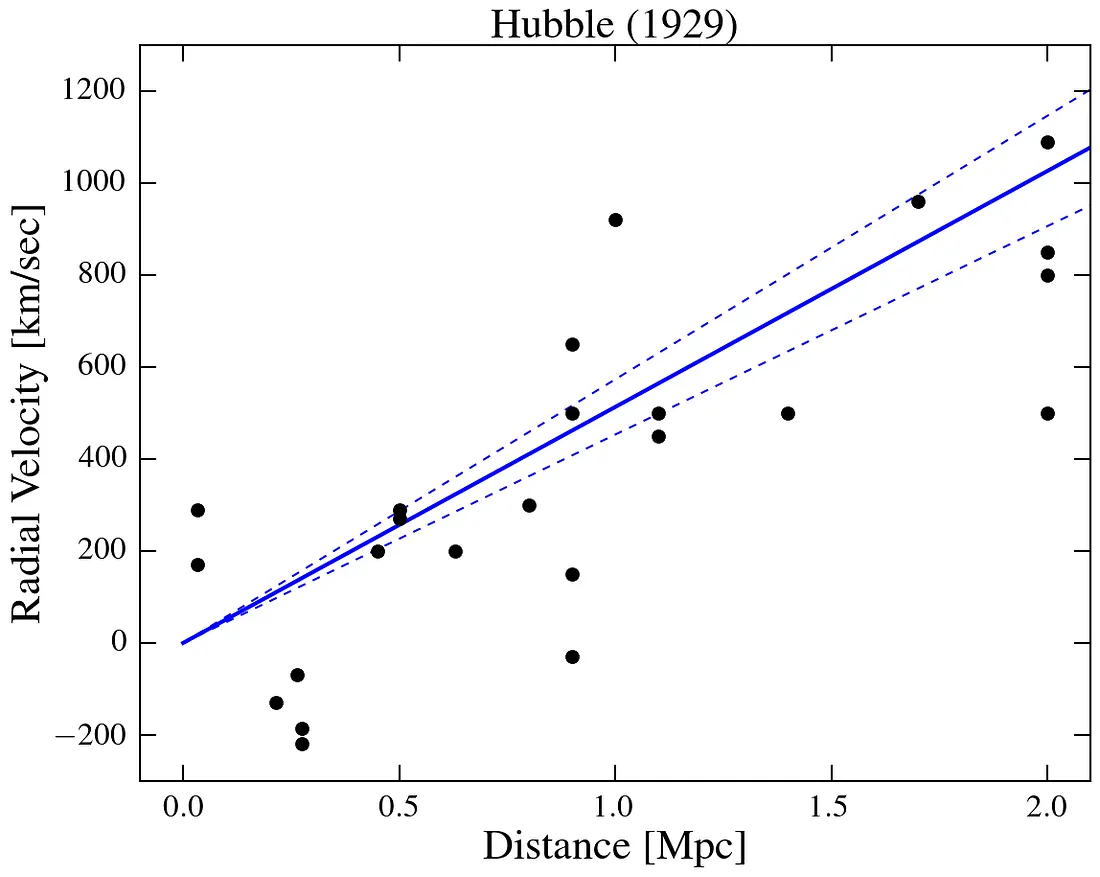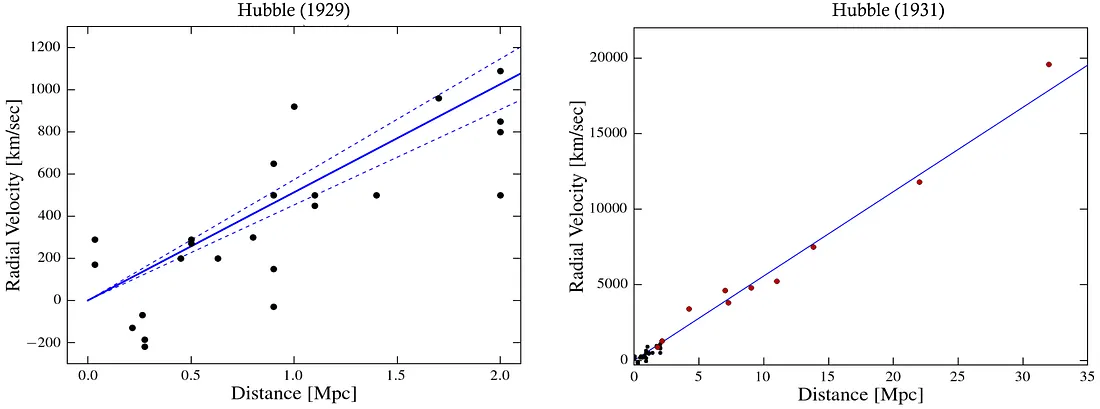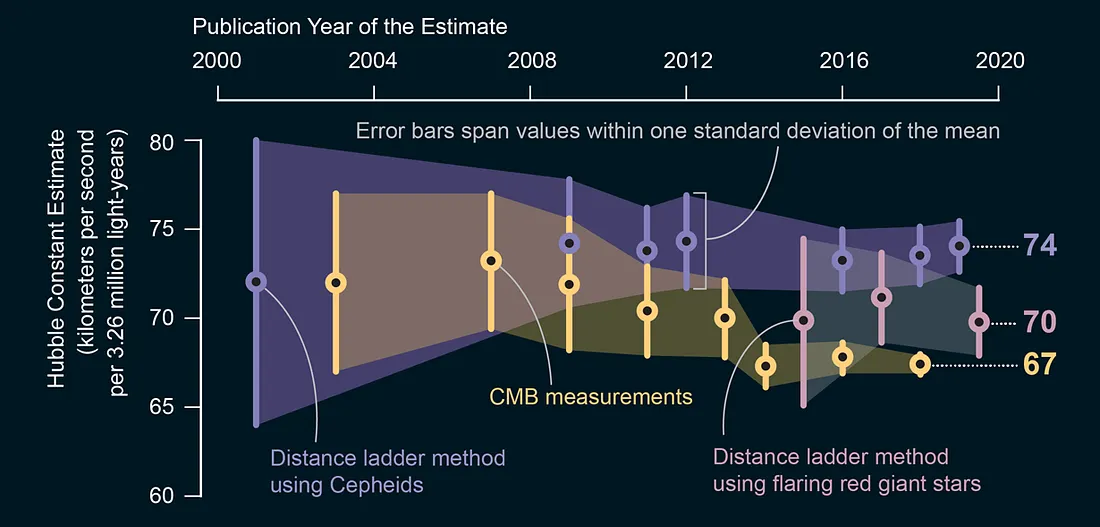Ana-Marija Nedić

Contact: amnedic AT umn DOT edu
Connect on LinkedIn
Codes repositories on GitHub
List of publications on Google Scholar
Maybe useful:
∙ Resources for young researchers
And some fun topics:
∙ Why is magnetic field denoted as ‘B’?
∙ How would you fit these data?
∙ Why a Nobel for blue LEDs?
∙ The times when Einstein blundered
How would you fit these data?
Blunt or brilliant? You probably wouldn’t have been bold enough to fit these data like Hubble did.

Three years before looking into these data, American astronomer Edwin Hubble concluded that among 400 objects thought of as the clouds of dust and gas and named nebulae, some were actually other galaxies. Working at Mt. Wilson’s telescope northeast of Los Angeles, he was able to distinguish the outer parts of some spiral galaxies as individual stars and found that there is more to the universe than only Milky Way. Today’s estimates suggest there are 200 billion galaxies (2×10¹¹) in the universe.
Then, in 1929, Hubble looked into the data for measured velocities and the distances to galaxies collected in the astronomical observations. The distances to the galaxies were determined from the brightness of the stars in those galaxies. The radial velocities are corrected for the Sun’s motion, where the positive radial velocity has the meaning the galaxy is moving away from us, while the negative means it is moving towards us.
Except for a few data points with negative radial velocity, the data (shown in the figure above) are following the trend — the farther galaxies are, the faster they are moving away from us. There were prior attempts to relate the velocity and the distance of the galaxies, but no conclusive correlation was found. From the full set of 46 data points available at the time, Hubble extracted 24 galaxies with the most reliable measurements of the velocities and distances and stated his conclusion. The correlation is linear.

Hubble’s original conclusion that the velocity vs. distance of galaxies follow the linear trend (left figure) is much more convincing from his new fit two years later (right figure), including the data from more distant galaxies (red dots).

Was he simply bold and a bit lucky, or did he also possess a deep intuition for the laws of the universe? Some view Hubble’s discovery as the most important milestone in astronomy in the 20th century because the conclusions which directly followed from it revolutionized our understanding of the universe. On the other hand, the data points which he initially fitted to the linear curve were sparse enough that this correlation he saw might be only up to chance.
Hubble’s law — the milestone in astronomy
Hubble estimated the slope in his linear fit to be 500 km/s/Mpc (kilometer per second per megaparsec), which is about 7 times greater than the best estimation of Hubble’s constant today, of about 70 km/s/Mpc. Hubble’s estimation of the slope (assuming the universe was expanding with a constant rate) gives the estimation that the age of the universe is 2 billion years, less than half the age of the Earth! The biggest source of the error was in estimating the distances of the galaxies, which was fixed in the second half of the previous century when the Hubble’s constant was estimated in the range between 50 to 90 km/s/Mpc.
However, more importantly at the time than the number, the trend Hubble discovered, today known as Hubble’s law, made a revolution in our understanding of the universe.
The correlation between the distance of the galaxies and their velocities is among the leading evidence suggesting that our universe is expanding and one of four pilar observations on which the Big Bang theory is built. Even though Hubble himself wasn’t the creator of the idea of expanding the universe, conventionally accepted understanding that our universe is static was questioned and subsequently rejected after he published his data analysis and his conclusion. When seeing Hubble’s conclusions, Einstein abandoned his work on artificially ‘fixing’ his equations of general relativity to make his model of the universe static (the attempt he later called himself his biggest blunder). The theoretical idea of the expanding universe was suggested a few years earlier. In 1922, Friedman derived this conclusion from his model of a homogenous isotropic universe. In 1927, Leimatre independently suggested some proportionality between the velocity and distance to the distant objects.
Hubble’s constant today
The value of Hubble’s constant has the meaning of the rate with which our universe is expanding, and the inverse value of Hubble’s constant gives the age of the universe if it was expanding with a constant speed.
While the traditional way to determine Hubble’s constant from the 1950s (calibrated distance ladder techniques) converged over time to the value of 73 km/s/Mpc, the new technique that started being used from the 2000s (from the cosmic microwave background radiation) converged to a different value for Hubble’s constant, 67 km/s/Mpc. Among the two measurements, the former is measuring how fast the universe is ought to be expanding from the prediction of the early universe, while the latter is measuring how fast it is expanding today as we see it. Since 2018 more techniques have been introduced, but with not small enough uncertainties to decide between the two values.

Credit: Jen Christiansen (schematics); Source: “The Carnegie-Chicago Hubble Program. VIII. An Independent Determination of the Hubble Constant Based on the Tip of the Red Giant Branch,” By Wendy L. Freedman et al., in Astrophysical Journal, Vol. 882, №1; August 29, 2019.
Although the exact value of the Hubble’s constant is important as it would give the rate with which the universe is expanding, not many astronomers or physicists were concerned with the exact number. However, the discrepancy between the two obtained values for Hubble’s constant from two different approaches becomes even stronger with new repeated measurements and is today known as the problem of Hubble’s constant.
However, the discrepancy between the estimated values of Hubble’s constant using different techniques has only strengthened with repeated measurements in attempts to resolve it, and it is now known as the problem of Hubble’s constant.
There is actually another quantity related to the Hubble’s constant which surprised many astronomers when the discovery was made in 1998. Previously, in a famous review article from 1970, observational cosmologist Allan Sandage described the entire cosmology as a “search for two numbers,” the velocity (Hubble’s constant) and deceleration with which the universe is expanding. Then, in 1998 it was surprising to find that our universe is expanding, but with acceleration. To explain the acceleration, the Big Bang model of the universe (from Friedman equation) suggests that there has to exist dark energy, and it would account for about 75% of all mass in the universe.
Consider taking a look at Hubble’s original 1929 paper, where he discussed his findings and data fitting.
Until next time!